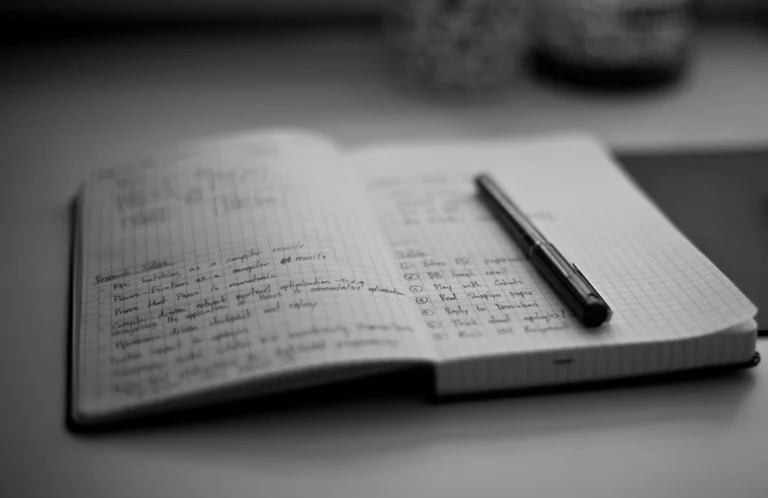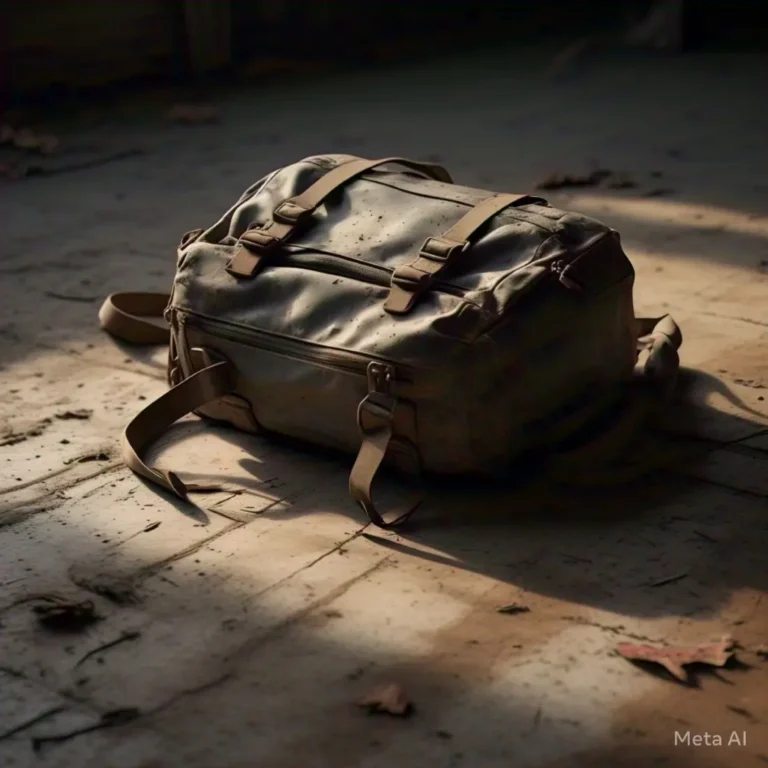If you’re a regular here, you know I’m a pen-and-paper person. It’s not just nostalgia (though there’s a bit of that too); the simple, tactile act of writing things down just works for my brain. A few years ago, I wrote about my analog system for managing work, and more recently, I built a web app called PenCode to make jotting down URLs in a notebook easier (I built it using GenAI, and wrote about my approach here).
But here’s the thing about notebooks: while they help me focus, keep me off screens, and even act as therapy some days, they aren’t perfect. They create friction between capturing an idea and acting on it. You end up with pages and pages of tasks, notes, and thoughts that become hard to search or revisit. This became especially problematic at work. You scribble a note in a meeting to follow up on something, but that action item is now trapped on a page. Unless you manually review and transfer it to a master list to action later, it’s easily forgotten. In fast-paced teams, the action items could soon pile up, and important tasks can slip through the cracks.
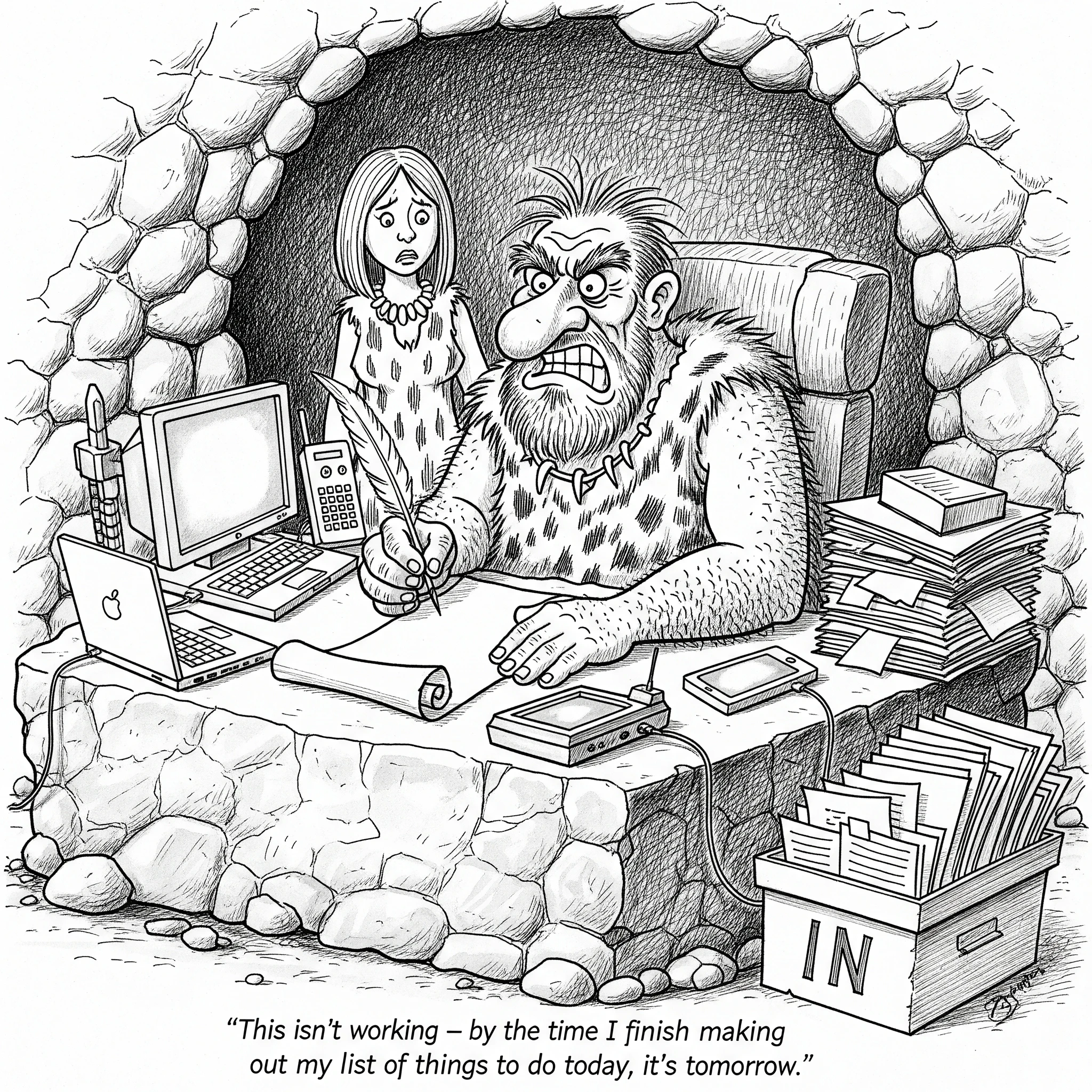
While I still swear by my analog system, this was a reality that required an upgrade.
After plenty of false starts with different apps and systems, I finally landed on a system that works for me. It’s a hybrid – part analog, part digital- built from first principles, and tailored to how I operate.
I’m sharing it here for fellow pen-and-paper enthusiasts who love the feel of a notebook but need the muscle of a digital system.
The Anatomy of My Hybrid System
My system is designed to leverage the advantages of both the physical and digital worlds. It consists of three core components that work in harmony.
1. The Physical Notebook: My Cockpit
This is where I work from each day. It’s built for immediate action and deep focus. At the start of the day, I write down a curated list of the 3-5 tasks from my digital notes that I’ve committed to for the day. This notebook comes with me to every meeting, and all the notes and action items during the day are jotted down here.
2. Obsidian: My Source of Truth
This is my master digital archive. It’s a simple folder on my computer containing plain-text Markdown files – one file for each day. While I use Obsidian to view and manage this folder, it’s just a tool that I prefer, but I can open, edit, and search these files with any text editor, and the system would still work perfectly.
I choose Obsidian as my primary interface because it excels at connecting ideas through features like backlinks and the graph view, turning my simple folder of “Daily Notes” into a powerful, interconnected knowledge base. But you can absolutely use any text editor you prefer – the core system remains fully functional.
3. A Python Script: The Automation Engine
This is the bridge between my digital archive and my daily actions. It’s a simple script that runs in the background, scanning all my Daily Notes to extract any pending tasks. It then generates a single, actionable report inside Obsidian called DASHBOARD.md. This dashboard gives me a clean, consolidated view of all my commitments, intelligently grouped by project or due date.
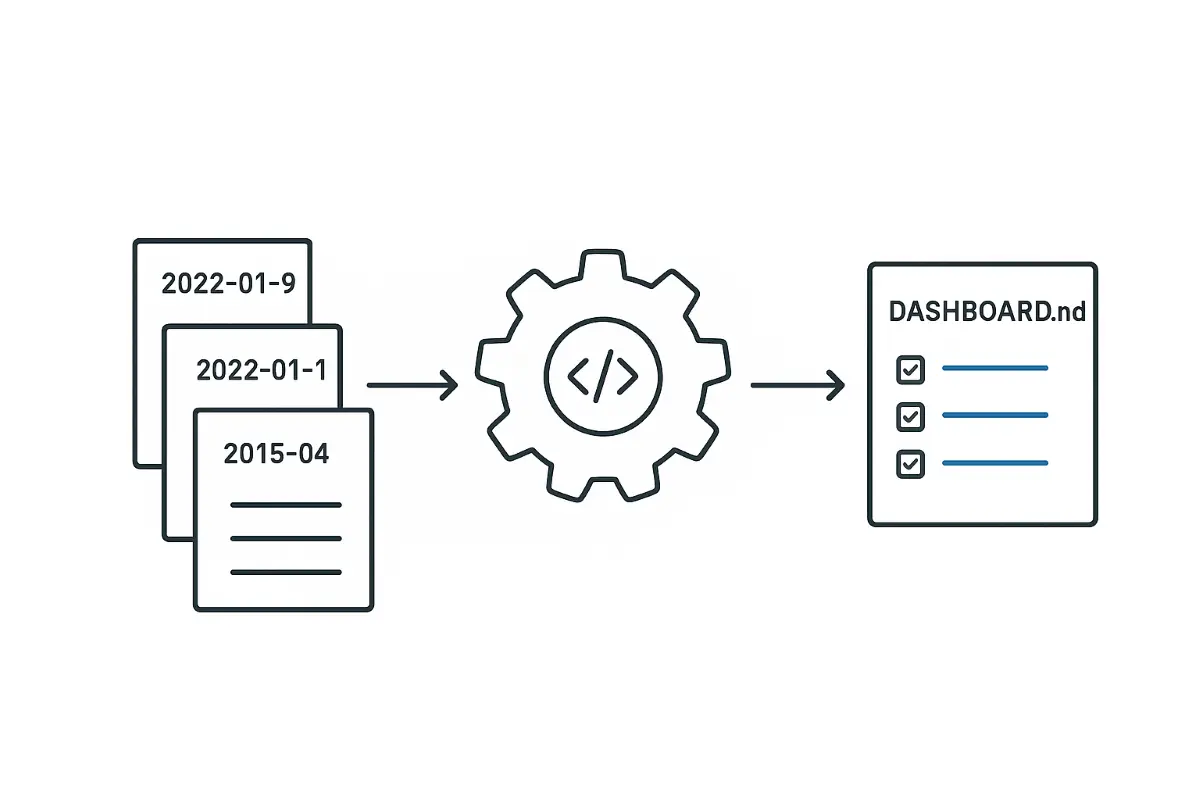
(A logical question is why not use an Obsidian plugin like Dateview that works similarly? The answer lies in the principle of separation of concerns. Python offers stronger text processing, works independently of Obsidian’s ecosystem, and keeps the app fast by handling heavy parsing in the background.)
With those components in place, the daily workflow becomes incredibly simple and powerful.
The Daily Workflow in Action
The process boils down to a simple, three-part daily ritual.
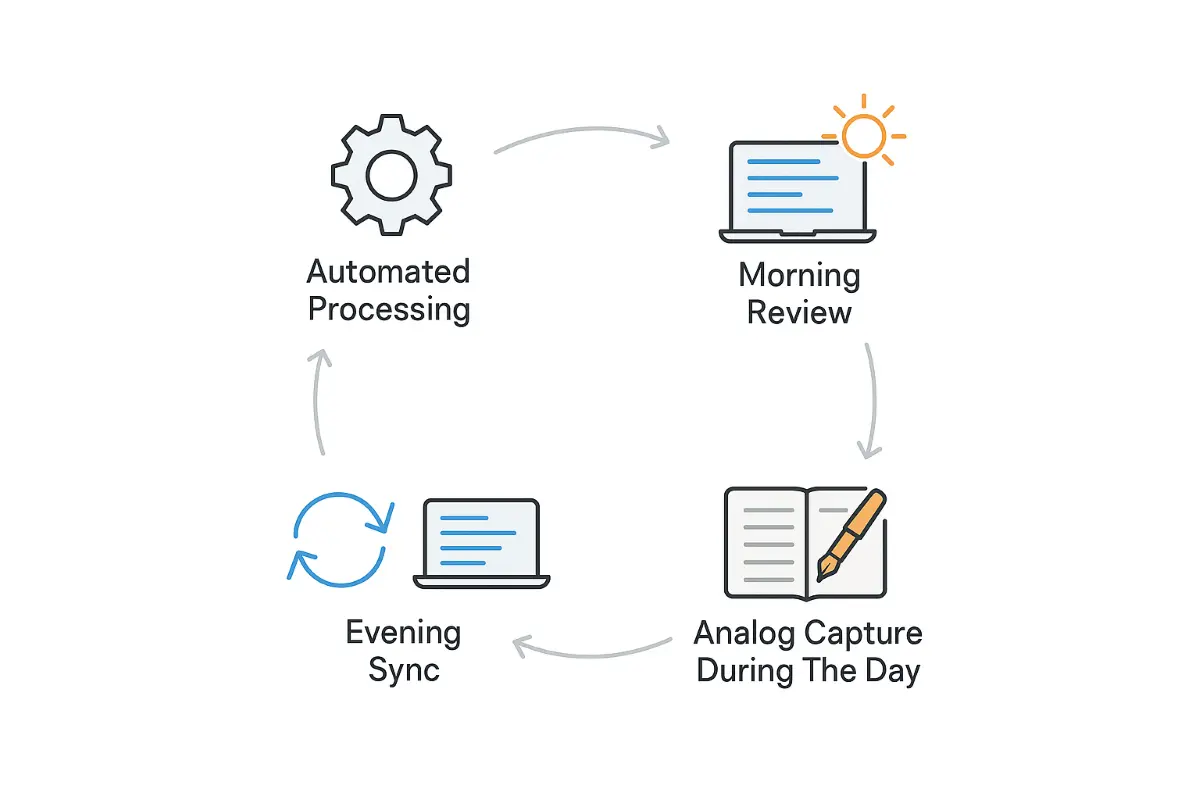
The Morning Briefing (5-10 Minutes)
I open Obsidian and look at my dashboard. From this master list, I manually select and write the day’s 3-5 most important tasks into my physical notebook. Then, I close Obsidian. Here is how the dashboard appears:
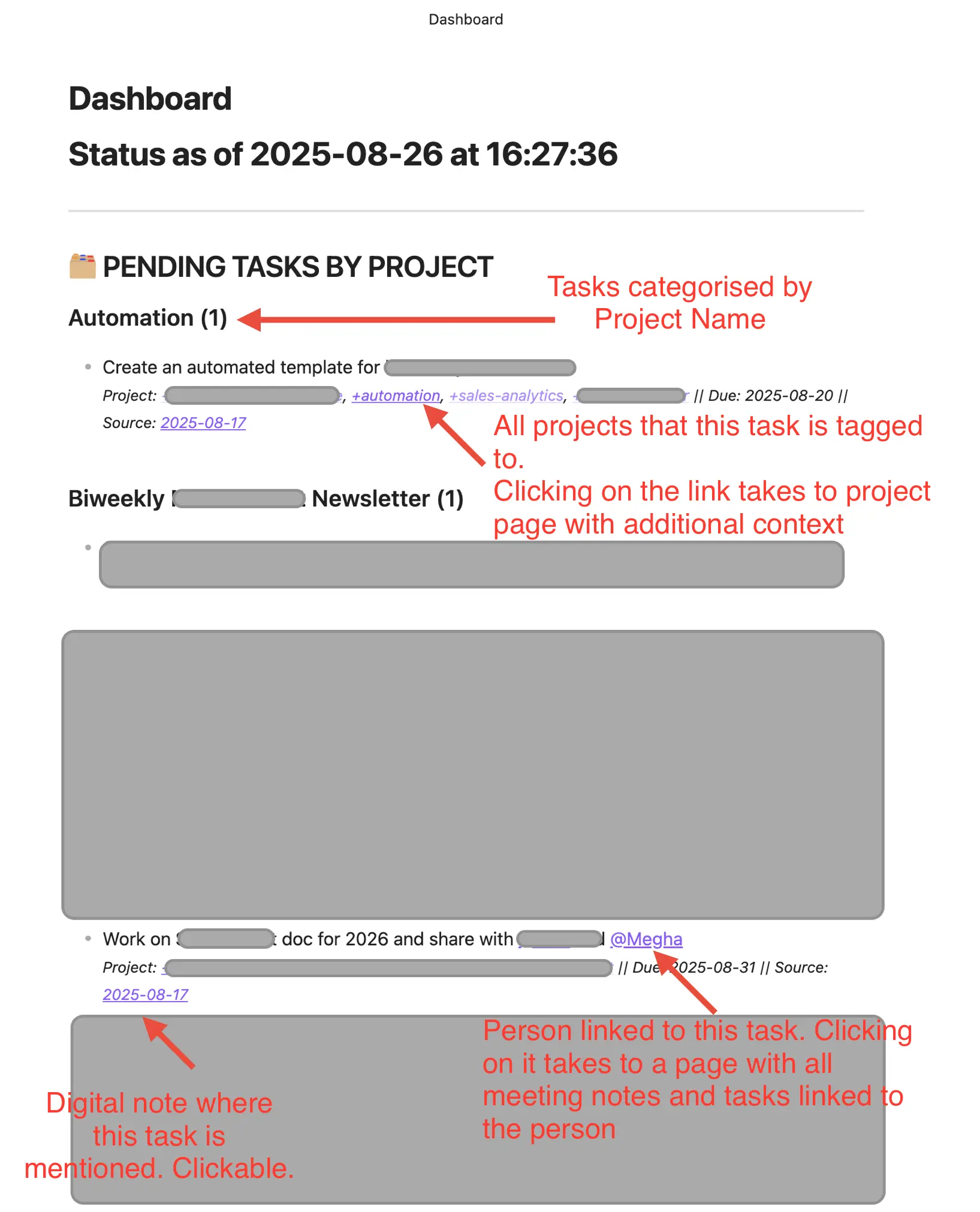
During the Day
I work exclusively from the notebook. It becomes my single capture device for any new ideas, tasks, and notes from meetings.
The Evening Sync (5-10 Minutes)
At the end of the day, I open Obsidian again. Looking at my notebook, I mark completed tasks as done ([x]) in their original source files and write any new tasks or important notes into that day’s digital note. The system is now up-to-date, ready for the Python script to process.
This simple sync ensures every handwritten note is digitally archived and searchable, keeping my analog workspace clean and ready for a fresh start the next day.
Friction is a Feature, Not a Bug
I know what you might be thinking – “all this manual transferring sounds inefficient.”
But that friction is a feature, not a bug.
“Perfection is achieved, not when there is nothing more to add, but when there is nothing left to take away.”
~ Antoine de Saint-Exupéry
In a world obsessed with one-click solutions, my system intentionally adds back a moment of mindful, manual step. The act of reviewing the digital dashboard and physically writing down tasks in my notebook forces a conscious moment of commitment. It makes me pause and ask:
Is this task still relevant?
Is it important enough to make it onto today’s list?
This deliberate friction prevents the mindless accumulation of digital clutter. You consciously choose what to commit to.
The same principle applies to the evening sync. Manually reviewing my handwritten notes forces me to reflect on the day and separate the signal from the noise. It’s a cathartic exercise that helps me process my thoughts and close the day with clarity.
So… Why Not Just Use a To-Do App?
I’ve deliberately traded some convenience for control, ownership, and a calmer workflow.
- I Own My Data, Forever.
My worklog is a simple folder of plain text files on my computer. This format is universal and will be readable in 50 years. With a third-party app, you’re essentially locked into their system. Your data lives inside their proprietary format, making you dependent on their pricing, their features, and their company’s future. My system is built to last. - It’s a Work Journal, Not Just a To-Do List.
Most to-do apps are terrible for capturing the context around tasks. My system seamlessly blends actionable tasks (- [ ]) and unstructured logs (Met with @ABC about the Q3 forecast...) in the same place, thus capturing the story of my work, not just the checklist. - Knowledge is Integrated, Not Isolated.
This is the killer feature. A project tag like[[+Project-XYZ]]is a clickable link to a central note containing all project tasks and notes. This helps build a personal knowledge base. The system relies on a simple, open text format for these links ([[wikilinks]]). While Obsidian provides a beautiful interface for this, the links themselves are just text, making the knowledge portable and future-proof. - Mindful Input, Automated Processing.
Most apps try to automate everything. My system does the opposite. The input – deciding what to work on and capturing new ideas – is intentionally manual and mindful. The processing – aggregating tasks and generating the dashboard – is fully automated. This puts my attention on the work itself, not on managing the tool.
The Toolkit
If you’re curious, here are the basic components to build such a system.
1. The Folder Structure:
A clean, logical structure is the foundation. Here’s how mine is set up:
my-work-log/
├── _scripts/
│ ├── generate_status.py
│ └── backup.sh
├── worklog/
│ ├── 2025-08-14.md
│ └── 2025-08-15.md
├── backups/
├── DASHBOARD.md2. The Scripts
generate_status.py: This is the brain of the system. It’s a single Python script that parses all daily notes and builds theDASHBOARD.mdreport. It runs automatically twice a day.backup.sh: This is the safety net. It runs nightly to create a compressed, timestamped backup of the entireworklogfolder.
The entire system is built on Markdown files. No databases. No dependencies.
The Real Challenge: Forging the Habit
The most sophisticated part of this system isn’t the Python script or the folder structure. It’s the simple, twice-daily ritual of opening and closing the loop.
Honestly, this is the hardest part. It’s easy to get excited about new tools, but the real transformation comes from the quiet discipline of the morning and evening sync. In the beginning, you will be tempted to skip it. You’ll finish a long day and think, “I’ll just do it tomorrow.”
This is the moment that defines whether the system works for you or not.
If you’re starting out, here is my advice:
- Anchor it to an existing habit. My evening sync happens immediately after I close my work laptop. It’s the final five minutes of my workday. My morning review happens while having my coffee. Linking the new ritual to an established one makes it nearly automatic.
- Focus on consistency, not perfection. There will be days when you miss the ritual, and that’s ok. Your goal should be not to miss it twice in a row. If you skip an evening, forgive yourself, but be doubly sure to show up the next morning.
- Remember the why. Those 10 minutes of daily review aren’t a chore. They are the investment you make to buy back hours of focused, uninterrupted work and a calmer, more organized mind.
This practice is the engine of the entire system. It’s what turns a collection of notes into a source of clarity.
I find my hybrid system to be powerful because of the intention it enforces. It gives me the searchable power of a digital archive combined with the quiet focus of an analog workspace.
This system is built on a philosophy of intentional, focused simplicity. As Leonardo da Vinci captured perfectly centuries ago:
“Simplicity is the ultimate sophistication.”
This is the key. Because in the end, tools don’t solve chaos. Systems do. The most effective system is one built around your own core philosophy, making it a system you can trust and adopt.
If you want to try something similar, or need the full Python script, please reach out.
Thanks for reading. Please leave a comment with your thoughts. And share this blog with whoever you think might like it.
Go Deeper on Data, Finance, and Productivity
If you enjoyed this article, you’ll love my newsletter, Compound Knowledge, where I share actionable ideas and the best resources I’ve found to help you uplevel your skills in data, finance, and productivity. It’s concise, valuable, and free.
Join the inner circle of readers and get insights directly in your inbox.
Photo Credit:
- Feature Image: Photo by Mille Sanders on Unsplash
- Cartoon created using Gemini
